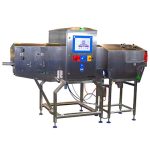Do you recollect the recall of nearly 250,000 pounds of a frozen chicken strips entree product due to a consumer discovering a piece of plastic in one of the chicken pieces, as announced by the USDA FSIS on September 2nd, 2023? Although food manufacturing facilities often implement diligent foreign material contaminant detection and control protocols, recalls due to foreign materials continue to happen. Therefore, it is critical for food businesses to understand the potential routes for foreign material contamination, analyze the challenges they bring, and employ a comprehensive approach to foreign material control and management, utilizing efficient methods to ensure consumer safety.
Origins of Foreign Material Contamination
The extraneous materials found in the food supply are defined by the FDA’s Food Defect Levels Handbook as “any foreign matter in a product associated with objectionable conditions or practices in production, storage, or distribution, including objectionable matter contributed by insects, rodents, and birds; decomposed material; and miscellaneous matter such as sand, soil, glass, rust, or other foreign substances.”
The origins of foreign substances found in food are commonly classified into five categories:
- Unintentional introduction from the field (stones, metal, insects, unwanted plant material like thorns or wood, soil, or small animals).
- Accidental inception during processing and handling (bone, glass, metal, wood, nuts, bolts, screening, cloth, grease, paint chips, rust, and similar items).
- Substances that enter the food during distribution (insects, metals, soil, or stones).
- Deliberate inclusion of materials in food (employee sabotage).
- Miscellaneous materials, such as struvite and other similar substances.
Not all foreign materials make a food item unsafe, but they all can have a profound effect on consumer satisfaction, which can result in negative publicity and decreased sales and regulatory compliance.
Foreign Object Contamination Risks and Challenges
Foreign material contamination in the food supply chain presents significant risks including:
Consumer Health Risks. Consuming contaminated food can lead to injuries such as broken teeth, choking, internal injuries, or illness if the foreign material carries pathogens. These incidents can result in severe health consequences, including hospitalization or even death, depending on the nature of the contaminant and the sensitivity of the consumer.
Regulatory Compliance. Regulations enforced by governmental agencies require strict adherence to food safety standards, including contamination prevention measures. Failure to comply with these regulations can lead to fines, legal penalties, product recalls, and even business closure.
Supply Chain Disruption. Contamination incidents can disrupt the flow of products through the supply chain, leading to delays, shortages, and increased operational costs. These disruptions can ripple through the entire industry, affecting a multitude of stakeholders.
Damage to Brand Value. Foreign material contamination incidents can tarnish a company’s reputation and erode consumer trust. News of contaminated products spreads rapidly through traditional and social media channels, leading to negative publicity and brand damage.
Financial Losses. The costs associated with product recalls, legal settlements, and loss of sales revenue can be significant and have long-term implications for profitability and sustainability.
Despite understanding the significant risks associated with foreign object contamination, these events continue to occur. That is because there are significant challenges in preventing and detecting foreign materials in food products, such as:
Supply Chain Complexity. The modern food supply chain is highly interconnected, involving numerous stakeholders, including farmers, processors, distributors, retailers, and consumers. Each step in the supply chain opens doors for contamination, making it challenging to trace the source of foreign materials accurately.
Implementation of Preventive Measures. Establishing effective preventive measures to mitigate the risk of foreign material contamination requires collaboration, investment, and ongoing vigilance. Verification of the efficacy of the employed preventive actions is often overlooked, which may lead to recurring foreign material presence.
Addressing these challenges requires a coordinated effort across the entire supply chain, with a focus on proactive risk management, quality assurance, and continuous improvement. The fundamental point remains that foreign substances should not be present in food items and hence, processors must create, record, execute, and sustain foreign material control programs to tackle these challenges and guarantee the exclusion of such materials from both their products and procedures.
Prevention Strategies
A foreign material management program is a protocol established to avert, identify, and investigate occurrences of foreign impurities within any food processing or manufacturing facility. An effective foreign material control program should adopt a holistic framework, integrating components that assess potential risks throughout the supply chain and establish appropriate preventive and corrective measures against foreign contamination. Following are the three key components to an effective program.
- Risk Assessment & Management in Farming
Food manufacturers and ingredient producers, including farmers and agronomists, must understand the specific risks and proper handling procedures of their ingredients to ensure food safety. Risk assessment in agriculture involves identifying hazards and vulnerabilities that could introduce foreign materials throughout the farming process, from planting to post-harvest handling.
Examples of hazards include contaminated water or soil, improper pesticide handling, inadequate pest control, and poor sanitation practices. Risk management involves scrutinizing farming operations to eliminate points of entry for foreign materials. Good Agricultural Practices (GAP) are crucial for controlling food safety hazards and are categorized into eleven segments, covering various aspects of farming practices. Compliance with GAP standards helps minimize the risk of contamination throughout the production process.
- Risk Assessment & Management in Receiving, Storage, and Transportation
In the context of receiving, storage, and transportation, the identification of potential sources of contamination is essential, with bulk shipments presenting significant challenges due to their susceptibility to foreign material introduction. Hazards during these stages can arise from various factors, including handling and environmental conditions.
Supplier approval programs serve to both ensure product safety and mitigate foreign material contamination risks. These programs primarily involve assessing suppliers’ food safety measures, including protocols for food handling and foreign object detection. Buyers can enforce measures such as sieving, screening, or employing metal detectors or X-ray machines before packaging, which should be specified in purchasing agreements. Effective risk management strategies involve thorough supplier verification and monitoring processes to ensure adherence to quality standards and practices. Intervention strategies, such as specific protocols for bulk deliveries, and communication with suppliers are required to prevent and address contamination issues promptly.
- Good Manufacturing Practices (GMP)
Good Manufacturing Processes are defined by regulatory agencies and developed to ensure that products are consistently produced following set quality standards. They cover multiple aspects of company operations that may allow for the introduction of foreign materials including:
Personnel. GMP dictates policies regarding attire and personal items for personnel involved in food processing, emphasizing the importance of verification programs to ensure the detectability of items within the processing environment.
Premises. Ensuring the proper condition and maintenance of the physical facility minimizes the risk of foreign material contamination. This includes regular upkeep and designated areas of operation to minimize the risk of cross-contamination. Effective waste management systems are also necessary to eliminate potential breeding grounds for contaminants.
Equipment Designing and Utensils. Equipment and utensils must be designed with materials resistant to shattering or splintering that feature smooth, non-porous surfaces for easy cleaning. Regular inspection and maintenance protocols are required to ensure equipment integrity and minimize the risk of foreign material contamination.
Preventive Maintenance. Preventive maintenance programs address equipment malfunctions before they pose a risk of contamination, with scheduled tasks tailored to the usage lifespan of different components. Timely replacement of parts is important to prevent failures that could compromise product safety.
Wood Control. Implementing a pallet management program helps prevent contamination from wooden pallets.
Glass and Brittle Plastic Controls. Food manufacturers are required to have a dedicated program for managing glass and brittle plastic as part of their GMP. This begins with establishing a policy prohibiting the presence or use of glass or ceramic objects in food processing areas or warehouses. A comprehensive inventory of all glass and brittle plastic items in food storage or handling areas, including their locations and protective measures, must be maintained.
Sanitation and Validation. Thorough cleaning and disinfection procedures are integral to maintaining sanitation standards, with validation processes to ensure the effectiveness of cleaning protocols. Comprehensive testing and verification are necessary and required to confirm the absence of contaminants.
Detection and Removal with Ongoing Surveillance. Various detection and removal methods, including sieves, electronic sorting, and centrifugation, can be employed to identify and eliminate foreign materials during processing. Collaboration with suppliers is key to optimizing detection equipment configurations and calibration, ensuring the removal of contaminants throughout the production process.
Innovative Approaches for Foreign Material Control
With technological advancements, innovative approaches have emerged to enhance foreign material detection and prevention processes. One such approach involves the use of advanced imaging technologies, such as X-ray inspection systems and metal detectors, which can identify foreign objects within food products. These systems utilize sophisticated algorithms to distinguish between desired food components and foreign materials, enabling manufacturers to detect contaminants with high precision. For example, X-ray inspection systems can detect metal, glass, plastic, and other dense foreign materials, while metal detectors are effective in identifying metallic contaminants.
The integration of artificial intelligence (AI) and machine learning algorithms has revolutionized foreign material control in the food industry. AI-powered systems can analyze vast amounts of data in real time to identify patterns and anomalies associated with foreign material contamination. This enables proactive detection and prevention measures, reducing the risk of foreign material incidents and product recalls.
For instance, AI algorithms can continuously monitor production lines for deviations from normal operating conditions and trigger alerts when potential contaminants are detected. Additionally, advancements in sensor technology, such as hyperspectral imaging and laser-based systems, offer enhanced sensitivity and specificity in detecting foreign materials, further improving food safety standards. Overall, these innovative approaches underscore the importance of leveraging technology to enhance foreign material control and uphold the highest standards of food safety in the industry.
By building and maintaining competent foreign material contamination management systems and incorporating new technologies, companies can safeguard product quality, protect consumers, and preserve brand reputation.








